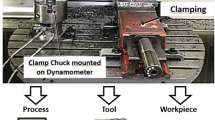Abstract
This paper presents a particular problem dealing with the apparition of burr during the drilling process in the aeronautic industry. This burr cannot exceed a height limit of 127 μm as set out by the aeronautical guidelines and must be eliminated before riveting. If this is not performed, it can cause structural damage which would constitute a danger due to the lack of safety. Moreover, the industry needs to find an automated and optimised process in which the drilling and deburring can be carried out in real time, eliminating those other unnecessary tasks, in order to obtain high-quality pieces. The work presents the applicability of data mining and machine learning techniques so as to obtain a real time burr detection model. This model could be implanted in the computer numerical control of the machine allowing the whole process to be automated and optimised. These techniques can be applied to other types of processes.
Similar content being viewed by others
References
Apolloni B, Ghosh A, Jain FALC, Patnaik S (2005) Machine learning and robot perception. Springer, Heidelberg
Berthold M, Hand DJ (2003) Intelligent data analysis. Springer, Berlin Heidelberg
Bukkapatnam STS, Kumara SRR, Lakhtakia A (1999) Analysis of acoustic emission signals in machining. J Manuf Sci Eng 121(4):568–571
Bukkapatnam STS, Kumara SRR, Lakhtakia A (2000) Fractal estimation of flank wear in turning. J Dyn Syst Meas Control 122:89–94
Chang SF, Simon SF, Bone GM (2010) Burr height model for vibration assisted drilling of aluminum 6061-T6. Precis Eng 34:369–375
Connell J, Mahadevan S (1993) Robot Learning. Kluwer Academic, Boston, MA
Correa M, Bielza C, de Ramírez MJ, Alique JR (2008) A Bayesian network model for surface roughness prediction in the machining process. Int J Syst Sci 39(12):1181–1192
Correa M, Bielza C, Pamies-Teixeira J (2009) Comparison of Bayesian networks and artificial neural networks for quality detection in a machining process. Expert Syst Appl 36:7270–7279
Ferreiro, S. and Arnaiz, A. (2010) Improving aircraft maintenance with innovative prognostics and health management techniques. Case of study: brake wear degradation, 2nd International Conference and Artificial intelligence, pp. 568–575.
Gaitonde VN, Karnik SR, Achyutha BT, Siddeswarappa B (2008) Genetic algorithm-based burr size minimization in drilling of AISI 316 L stainless steel. J Mater Process Technol 197(1–3):225–236
Gaitonde VN, Kanik SR, Achyutha BT, Siddeswarappa B (2008) Taguchi optimization in drilling of AISI 316 L stainless steel to minimize burr size using multiperformance objective based on membership function. J Mater Process Technol 202(1–3):374–379
Hambli R (2002) Prediction of burr height formation in blanking processes using neural network. Int J Mech Sci 44:2089–2102
Heisel U, Luik M, Eisseler R, Schaal M (2005) Prediction of parameters for the burr dimensions in short-hole drilling. Annals of the CIRP 54(1):79–82
How T, Liu W, Lin L (2003) Intelligent remote monitoring and diagnosis of manufacturing processes using an integrated approach of neural networks and rough sets. J Intell Manuf 14:239–253
Kamarthi SV, Kumara SRT, Cohen PH (2000) Flank wear estimation in turning through wavelet representation of acoustic emission signals. J Manuf Sci Eng 122:12–19
Kim J, Min S, Dornfeld DA (2000) Optimization and control drilling burr formation of AISI 304 L and AISI 4118 based on drilling burr control charts. Int J Mach Tool Manufact 41:923–936
Lauderbaugh LK (2009) Analysis of the effects of process parameters on exit burrs in drilling using a combined simulation and experimental approach. J Mater Process Technol 209(4):1909–1919
Malakooti B, Raman V (2000) An iteractive multi-objective artificial neural network approach for machine setup optimization. J Intell Manuf 11:41–50
Melvin DG, Niranjan M, Prager RW, Trull AK, Hughes VF (2000) Neurocomputting versus linear statistical techniques applied to liver transplant monitoring: a comparative study. IEEE Trans Biomed Eng 47:1036–1043
Michalsky RS, Bratko I, Kubat M (1998) Machine learning and data mining: methods and applications. Wiley, New York
Min S, Kim J, Dornfeld DA (2001) Development of a drilling burr control chart for low alloy steel AISI 4118. J Mater Process Technol 113:4–9
Mitchell TM (1997) Machine learning. McGrawHill, New York
Nieves J, Santos I, Penya YK, Rojas S, Salazar M, Bringas PG (2009) Mechanical properties prediction in high-precision foundry production. In: Proceedings of the 7th IEEE International Conference on Industrial Informatics. pp. 31–36
Peña, B., Aramendi, G. and Rivero, M.A. (2007) Method for monitoring burr formation in processes involving the drilling of parts. Spain, patent application, WO2007/065959A1.
Pittner S, Kamarthi SV (2002) Feature extraction from wavelet coefficients for pattern recognition tasks. Neural Network 1997(3):1484–1489
Rangwala SS, Dornfeld DA (2002) Learning and optimization of machining operations using computing abilities of neural networks. IEEE Transactions on Systems, Man and Cybernetics 19(2):299–314
Russel S, Norvig P (1995) Artificial intelligence: a modern approach. Prentice Hall, Englewood Cliffs, NJ
Sick B (2002) On-line and indirect tool wear monitoring in turning with artificial neural networks: a review of more than a decade of research. Mech Syst Signal Process 16(4):487–546
Umbrello D, Ambrogio G, Filice L, Guerriero F, Guido R (2009) A clustering approach for determining the optimal process parameters in cutting. J Intell Manuf 21(6):787–795
Wang K (2007) Applying data mining to manufacturing: the nature and implications. J Intell Manuf 18(4):487–495
Witten IH, Frank E (2000) Data mining: practical machine learning tools and techniques with Java implementations. Morgan Kaufmann, San Francisco
Wolber WH, Street WN, Mangasarian OL (1994) Machine learning techniques to diagnose breast cancer from fine-needle aspirates. Cancer Letters 77:163–171
Author information
Authors and Affiliations
Corresponding author
Rights and permissions
About this article
Cite this article
Ferreiro, S., Sierra, B. Comparison of machine learning algorithms for optimization and improvement of process quality in conventional metallic materials. Int J Adv Manuf Technol 60, 237–249 (2012). https://doi.org/10.1007/s00170-011-3578-x
Received:
Accepted:
Published:
Issue Date:
DOI: https://doi.org/10.1007/s00170-011-3578-x




